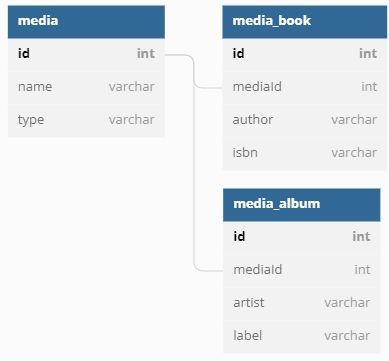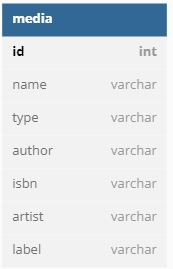Subclass Entities
By default, Quick supports basic component-level inheritance of entities, meaning that a child component inherits the properties ( and ability to overload ) its parent. A common, object-oriented relational database pattern, however is to provide additional definition on parent tables ( and classes ) within child tables which contain a foreign key.
Quick supports two types of child classes: Discriminated and Subclassed child entities. In both cases, loading any child class will also deliver the data of its parent class.
Subclass Entities
Let's say, for example, that I have a Media entity, which is used to catalog and organize all media items loaded in to my application.
component
table="media"
extends="quick.models.BaseEntity"
accessors="true"
{
property name="id";
property name="uploadFileName";
property name="fileLocation";
property name="fileSizeBytes";
}My Media entity contains all of the properties which are common to every media item uploaded in to my application. Let's say, however, that I need to have specific attributes that are available on only media for my Book entity ( e.g. whether the image is the cover photo, for example ). I can create a child class of BookMedia which extends my Media entity. When loaded, all of the properties of Media will be loaded along with the custom attributes which apply to my BookMedia object:
component
extends="Media"
table="book_media"
joinColumn="FK_media"
accessors="true"
{
property name="displayOrder";
property name="designation";
function approvalStatus(){
return belongsTo( "Book", "FK_book" );
}
}Note the additional component attribute joincolumn. The presence of this attribute on a child class signifies that it is a child entity of the parent and that the parent's properties should be loaded whenever the BookMedia entity is loaded. In addition, the primary key of the entity is that of the parent.
Child entities can be retrieved by queries specific to their own properties:
Or properties on the parent class can be used as first-class properties within the query:
Child entities can be retrieved, individually, using the value of the joinColumn, which should be a foreign key to the parent identifier column:
Now my Book entity can use its extended media class to retrieve media items which are specific to its own purpose:
Discriminated Entities
A discriminated child class functions, basically, in the same way as a subclassed entity, with one exception: The parent entity is aware of the discriminated child due to a discriminatorValue attribute and will return a specific subclass when a retrieval is performed through the parent Entity. This pattern is also known as polymorphic association.
Quick supports two different types of discriminated entities defined by single-table inheritance (STI) or multi-table inheritance (MTI). Your database schema will determine the most appropriate inheritance pattern for your use case.
Let's take our BookMedia class again, but this time, define it as a discriminated entity.
The first step is to add the discriminatorColumn attribute to the Media entity, which is used to differentiate the subclass entities. Next, define an array of possible discriminated entities for the parent. This is so we don't have to scan all Quick components just to determine if there are any discriminated entities.
Then we set a discriminatorValue property on the child class, the value of which is stored in the parent entity table, which differentiates the different subclasses.
Then we set a discriminatorValue property on the child class, the value of which is stored in the parent entity table:
We aren’t entirely done yet. Finally, we must tell Quick whether we are using multi-table inheritance or single-table inheritance so it can map the database data to the subclass entities.
Multi-Table Inheritance (MTI)
If the data for your discriminated entities is normalized across multiple tables, you should use the multi-table inheritance (MTI) method for creating discriminated entities. In the example below, The Media entity has two subclasses, MediaBook and MediaAlbum. The discriminator column for the entities is the type column in the media table and the distinct properties for each subclass come from the media_book and media_album tables.

To inform Quick that our database schema follows the MTI pattern, we must add a joinColumn and table values for each subclass.
Single Table Inheritance (STI)
If the data for your discriminated entities lives in a single table, you should use the single-table inheritance (STI) method for creating discriminated entities. In the example below, the Media entity has two subclasses, MediaBook and MediaAlbum. The discriminator column for the entities is the type column in the media table, and the distinct properties for each subclass come from a single table.

To inform Quick that our database schema follows the STI pattern, we must also add singleTableInheritance=true to the parent entity.
Retrieving Discriminated Entities
Once the parent and child entities are defined, new BookMedia entities will be saved with a type value of "book" in the media table. As such, the following query will result in only entities of BookMedia being returned:
If our Media table contains a combination of non-book and book media, then the collection returned when querying all records will contain a mix of Media entities such as BookMedia and AlbumMedia
If you want to create a brand-new entity of a specific subclass, you can do so by calling newChildEntity( discriminatorValue ) like this:
Summary
Discriminated and child class entities, allow for a more Object oriented approach to entity-specific relationships by allowing you to eliminate pivot/join tables and extend the attributes of the base class.
Was this helpful?